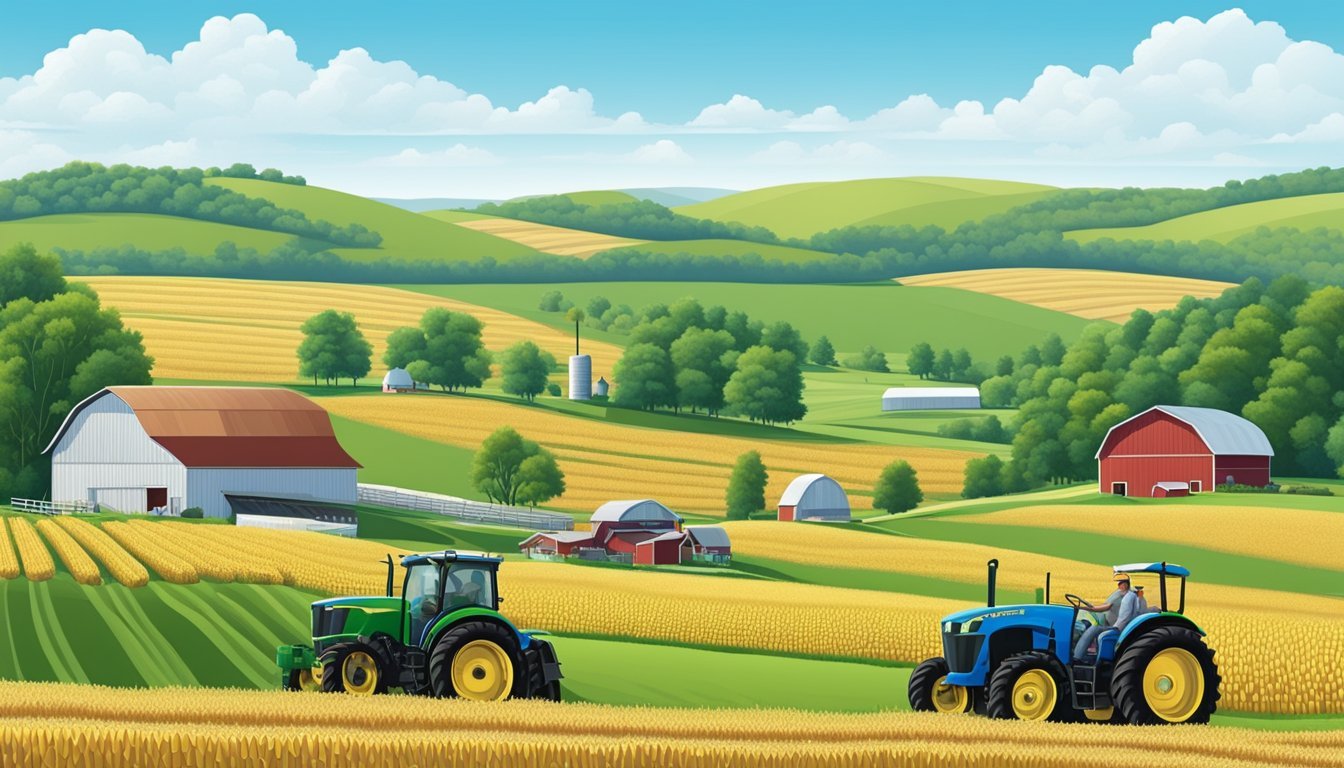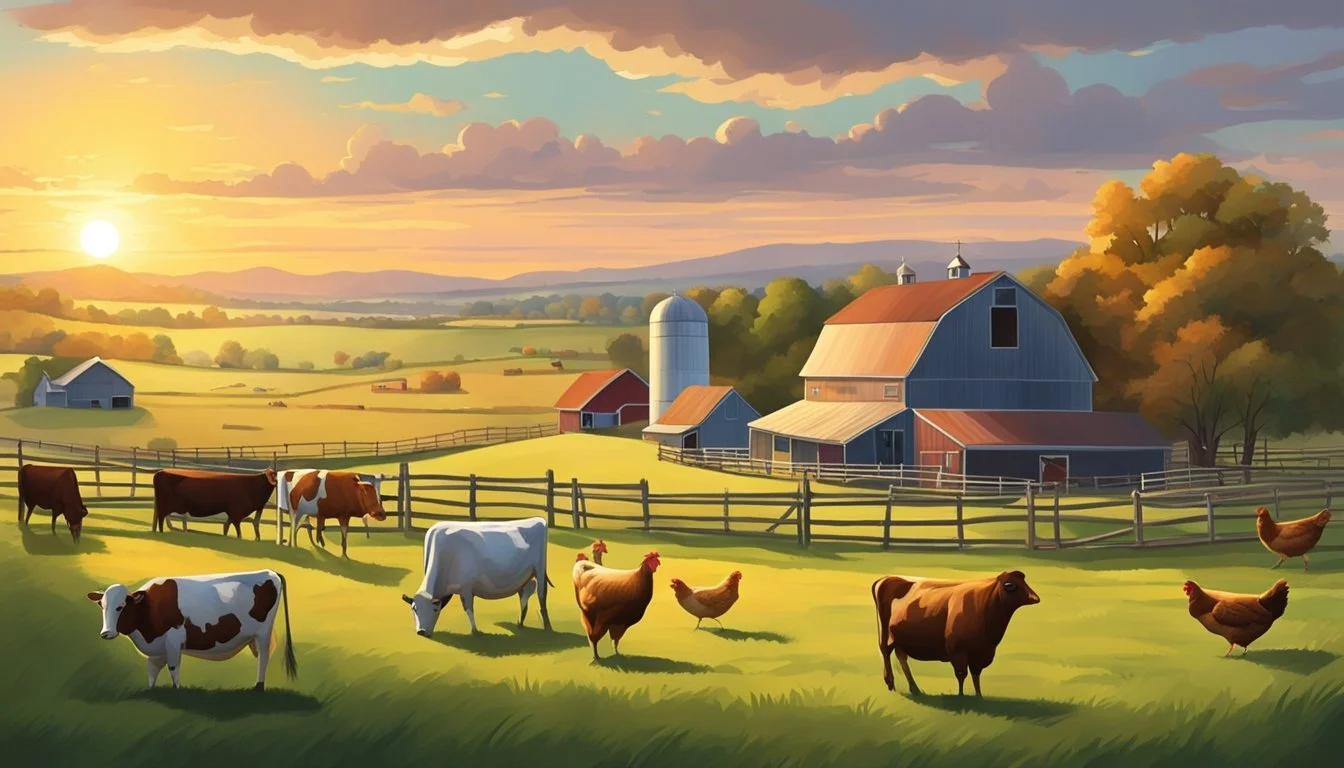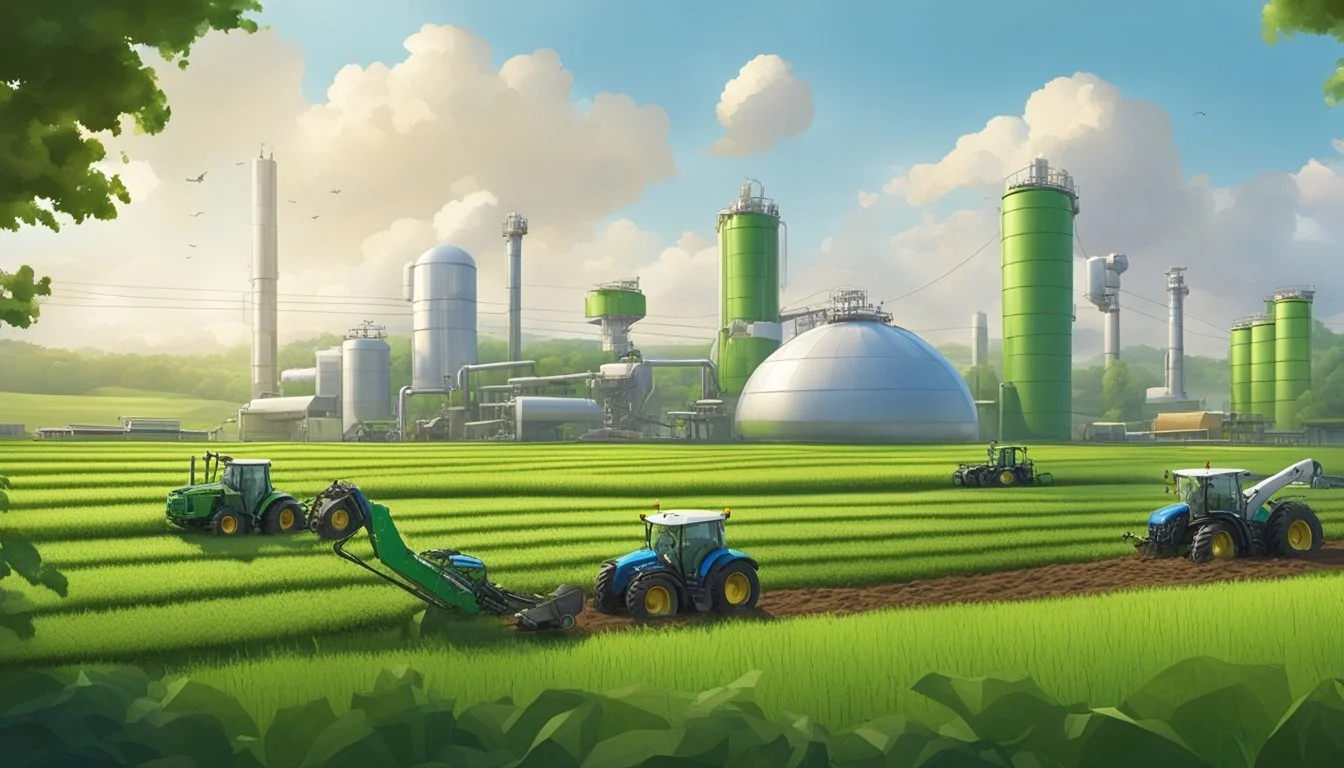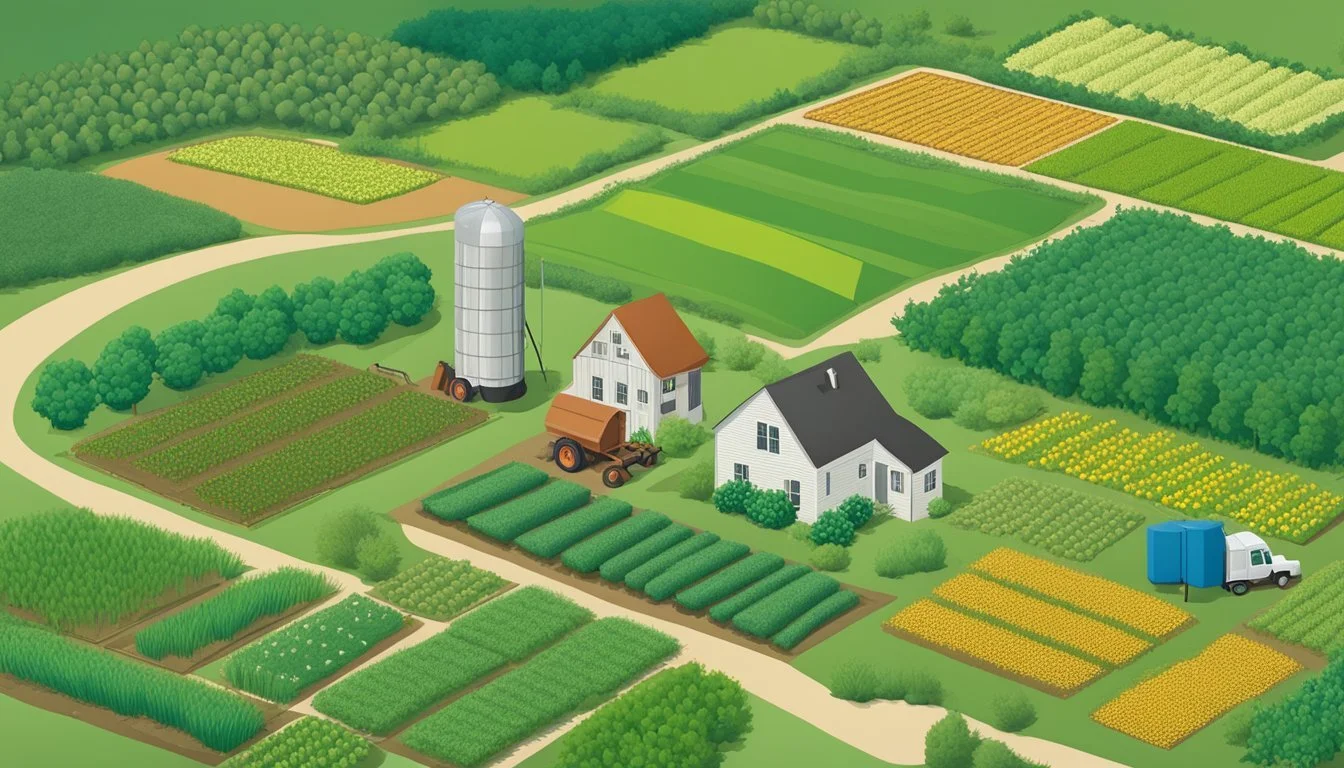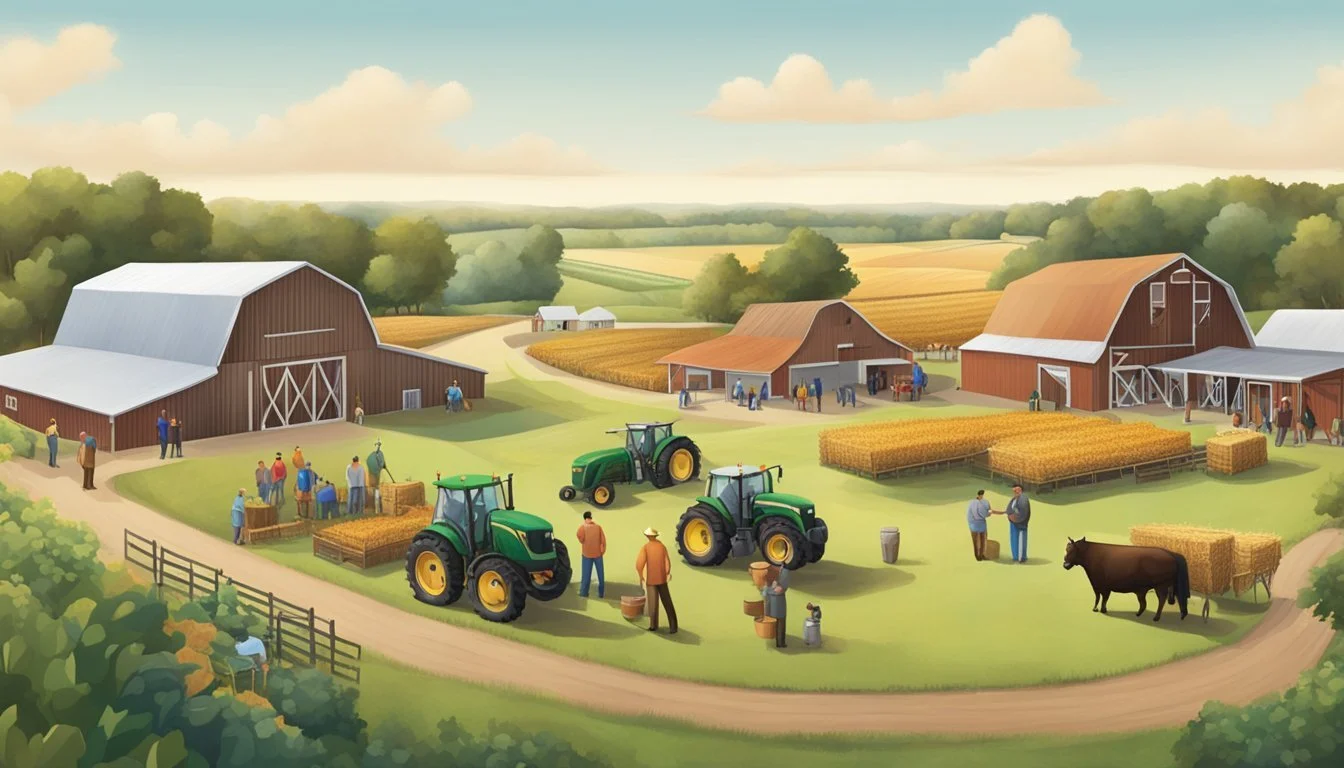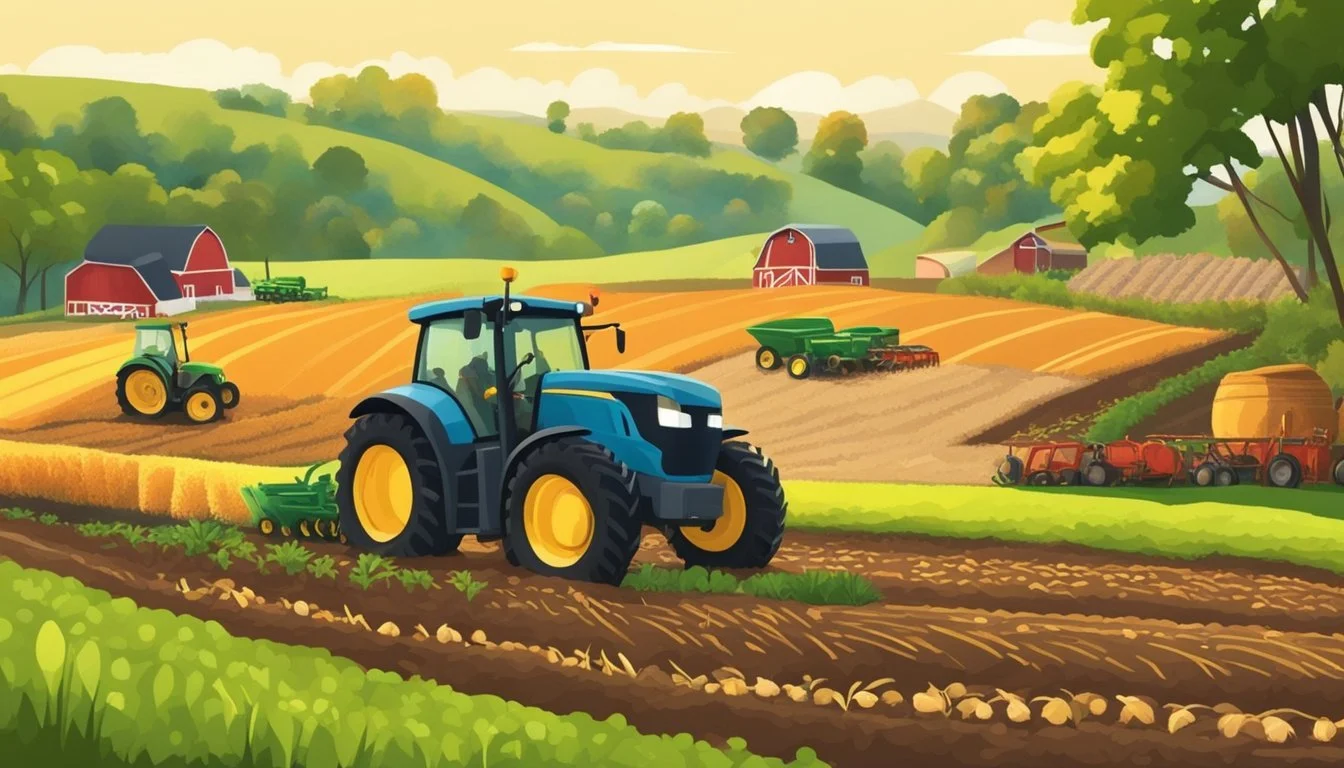Guide to Farming in Ohio
Essential Tips for Buckeye State Agrarians
This Article is Part of Our State by State Farming Guide
Ohio stands as a beacon of agricultural tradition and innovation, with a rich farming heritage that continues to evolve. The state's diverse agriculture sector ranks among the leaders in production value, underpinned by commodities like poultry, cattle, soybeans, (how long do soybeans last?) corn, pork, and dairy. Ohio's ecological variety supports an array of agricultural activities, from the cultivation of various grain crops to livestock farming and the production of specialty items such as blueberries, strawberries, and honeybees.
The landscape of farming in Ohio is, however, marked by a transition phase, with an aging farmer demographic that sees a median age of 56.8. This shift emphasizes the critical need for new practitioners to enter the profession and take the helm of Ohio's agricultural future. Aspiring farmers face hurdles such as high land and equipment costs, yet the state is making strides to facilitate entry into this vital sector. Initiatives and tax credit programs aim to reduce barriers and support new farmers in establishing sustainable operations.
Support and resources for new and aspiring farmers are readily available in Ohio, featuring programs through Go Farm Ohio, Penn State Extension, and Iowa State University Extension. These resources provide essential information and guidance on starting and managing small farms. Additionally, organizations such as the Ohio Farm Bureau advocate for strong agricultural communities, emphasizing education and membership programs to nurture the next generation of farmers and ensure the continuity of Ohio's agricultural legacy.
Overview of Ohio Agriculture
Ohio stands out in agricultural production, with a strong presence in both crop and livestock sectors. The state's diverse climate and commitment to agricultural research support a robust and economically significant industry.
Ohio's Climate and Agriculture Industry
Ohio's temperate climate with well-distributed precipitation throughout the year establishes a conducive environment for a variety of agricultural ventures. The state experiences four distinct seasons, with cold winters and warm summers that are ideal for the growth of both cool and warm season crops.
Key Agricultural Resources and Commodities:
Soil: Ohio's rich soil is a fundamental resource, particularly conducive to corn and soybean cultivation, which are among the state's top commodity crops.
Precipitation: The state benefits from an average annual rainfall of 39 inches, which is favorable for crop irrigation and pasture growth.
Temperature: With an average growing season of 160 days, farmers are able to produce a wide range of products.
Economic Impact of Farming in Ohio
Agriculture is a cornerstone of Ohio's economy, contributing significantly through its various sectors.
Farming Facts and Figures:
Number of Farms: Approximately 75,000
Total Acres of Farmland: 13.1 million acres
Economic Contribution: $124 billion annually
Family-Run Farms: Nearly 90% of Ohio's farms are family-owned or operated.
Ohio excels in several areas on the national stage:
Dairy: The state is a leading producer of Swiss cheese.
Eggs: Ohio ranks second in egg production across the United States.
Produce: It secures third place in the production of tomatoes and pumpkins.
The agriculture sector's success is supported by ongoing research and educational programs, which provide adaptive results and recommendations to optimize production and sustainability.
Getting Started in Farming
Making the venture into Ohio's agricultural sector requires careful planning and access to a variety of resources. For those new to the field, developing a comprehensive business plan, sourcing financing, and tapping into support programs can make all the difference.
Resources for Beginning Farmers
Ohio Farm Bureau (OFB) offers guidance for individuals who have not operated a farm for more than 10 years and do not own significantly large operations. Resources available include:
Networking opportunities: Connect with experienced farmers.
Education: Access to farming courses and material.
Market insights: Information on local demand and farming trends.
Creating a Business Plan
A well-crafted business plan is crucial for success in farming:
Market Analysis: Understand the demand for your farm's products.
Operations Plan: Define the farming activities and the resources required.
Financial Projections: Outline the cost, revenue, and profitability forecasts.
Financing and Support Programs
Beginning farmers in Ohio can explore financing options from the Farm Service Agency (FSA) and support from institutions like Farm Credit Mid-America:
Loans: Tailored for new farmers, with criteria including farming experience and land ownership.
Mentorship: Seasoned farmers acting as mentors to guide newcomers.
Financial support: Programs to assist with the purchasing of land and equipment.
Various tax credits and additional financial incentives may be available for those who qualify under the definition of a beginning farmer in Ohio, encouraging the entrance into agriculture.
Land Management and Conservation
Land management and conservation in Ohio are integral parts of ensuring the sustainability of agriculture. These practices aim to balance productive farming with the stewardship of natural resources for future generations.
Soil Fertility and Preservation
Soil fertility is the backbone of productive agriculture. Ohio farmers employ soil testing to assess nutrient levels and make informed fertilizer applications. Conservation efforts include using cover crops to prevent soil erosion and enhance soil health. These practices maintain the soil's ability to sustain agricultural production over time.
Water Management Practices
Efficient water management is crucial for Ohio's agricultural success. Farmers implement irrigation tactics that reduce water waste, such as drip irrigation systems. Measures also include constructing waterways and retention basins to manage runoff, protecting both soil fertility and water resources from contamination.
The Importance of Crop Rotation
Crop rotation is a time-tested practice contributing to land conservation in Ohio. Rotating different crops prevents nutrient depletion, lowers pest pressure, and breaks disease cycles. It leads to healthier crops and minimizes the need for chemical interventions. This practice is a primary component of sustainable agriculture and plays a significant role in preserving natural resources.
Crop Production and Selection
Ohio's agriculture thrives on a diverse range of crops, with corn and soybeans leading the production. This section provides an insight into the selection and cultivation of these primary crops, alongside small grains and forages, while also offering a comparison between organic and conventional farming practices.
Growing Corn and Soybeans
Ohio soil and climatic conditions favor the growth of corn and soybeans, making them staple crops in the state's farming landscape. Corn requires well-drained, fertile soil and is sensitive to the timing of planting to avoid frost damage and optimize yield. Farmers should consider hybrids that are proven to perform well in their specific regions of Ohio. Soybeans are adaptable to a range of soil types but grow best in slightly acidic to neutral pH soils. They require less nitrogen fertilization as they can fix atmospheric nitrogen, which makes them a good crop for rotation.
Small Grain and Forage Crops
When it comes to small grain crops, such as wheat, oats, and barley, Ohio farmers typically plant them in the fall. These crops are not only valuable for grain production but also serve as cover crops that help in soil conservation. Forage crops are vital for livestock feeding and soil improvement. Consistent with Ohio's agronomic guidelines, alfalfa and clover are common forage crops, requiring proper management of soil fertility and pest control to ensure high-quality yield.
Organic vs Conventional Farming
Organic farming in Ohio distinguishes itself by the absence of synthetic inputs for crop production. Instead, it utilizes natural processes and materials to build soil fertility and control pests. Certification has strict standards adhering to organic principles. Contrastingly, conventional farming employs a broader range of chemical inputs for maximizing yield and managing pests and diseases. Conventional methods might offer higher yields but involve more rigorous management of soil and water to mitigate the impact of synthetic inputs.
Both farming practices demand precise management strategies in Ohio to ensure sustainability and productivity of the farmland, while adhering to the state's environmental regulations and agronomic research aimed at optimizing resource inputs.
Livestock and Poultry Farming
Ohio’s rich agricultural tradition includes a strong focus on livestock and poultry farming, covering the care of cattle and pork, the operation of poultry farms, and the implementation of sustainable practices to ensure productivity and environmental stewardship.
Raising Cattle and Pork
Raising cattle and pork in Ohio involves adhering to specific care standards to maintain animal welfare and product quality. The state is home to numerous cattle and pork farms that must comply with regulations regarding space, nutrition, and health treatments. For cattle, Ohio offers abundant pastureland, which is conducive to both beef and dairy farming. In terms of pork, farmers focus on providing quality feed and maintaining clean, properly ventilated facilities to promote healthy growth.
Requirements for Raising Livestock Description Space Adequate room for animals to move and grow. Nutrition High-quality feed tailored to livestock needs. Health Regular veterinary care and vaccinations.
Starting a Poultry Farm
To start a poultry farm in Ohio, prospective farmers must consider zoning regulations, biosecurity measures, and flock management. Poultry farming in Ohio can involve layers, broilers, or both, with each segment requiring different facilities. Chickens require temperature-controlled environments and protection from predators and disease.
Key Considerations for Poultry Farming Description Biosecurity Measures to prevent disease outbreaks. Housing Temperature-controlled coops with proper ventilation. Flock Management Regular health assessments and egg quality checks.
Sustainable Practices for Livestock
Implementing sustainable practices is vital for the future of livestock farming in Ohio. The Ohio Department of Agriculture’s Division of Livestock Environmental Permitting oversees the environmental aspects of the state's largest livestock and poultry facilities. Sustainable practices include manure management, minimizing water pollution from runoff, and ensuring the welfare of animals. A balance between productivity and environmental health is crucial.
Sustainable Practice Benefit Manure Management Reduces waste and replenishes soil nutrients. Water Conservation Prevents pollution and conserves resources. Animal Welfare Promotes healthy livestock and quality products.
Agricultural Technology and Research
Advancements in agricultural technology and the application of thorough research have revolutionized farming practices in Ohio. Precise management techniques now interface with robust data collection to enhance productivity and sustainability on Ohio farms.
Precision Agriculture Advancements
Precision agriculture in Ohio incorporates technologies like auto-guidance systems, variable-rate technology (VRT), and yield monitors. These innovations allow for more efficient use of resources and optimized field operations. For example, auto-guidance ensures straighter planting rows, while VRT adjusts inputs like seeds and fertilizer to match soil variability. Yield monitors collect data for better decision-making in subsequent seasons.
Seed Evaluation and Test Plots
Seed evaluation and the development of test plots are vital for assessing the potential performance of various crop varieties under local conditions. Ohio State University's agricultural programs frequently conduct seed trials to measure traits such as disease resistance, drought tolerance, and yield stability. These trials provide farmers with adaptive results that inform sound seed selection.
On-Farm Research for Adaptive Results
On-farm research initiatives in Ohio enable farmers to experiment with and adapt novel agricultural practices in a real-world context. This research covers areas like soil management, plant nutrition, and pest control. The Ohio Agronomy Guide serves as a compendium of these adaptive research results, offering evidenced recommendations to farmers for improving their crop production systems.
Pest and Weed Management
Pest and weed management in farming is essential for maintaining crop health and ensuring high yields. Effective strategies involve a combination of approaches tailored to Ohio's specific agricultural conditions.
Integrated Pest Management
Integrated Pest Management (IPM) is a holistic approach that combines biological, cultural, physical, and chemical tools in a way that minimizes economic, health, and environmental risks. In Ohio, farmers take into account the lifecycle of pests, including insects, and their interaction with the environment. This information is used to manage pest damage by the most economical means, with the least possible hazard to people, property, and the environment.
Monitoring: Regular inspection of crops to identify pest pressure and determine action thresholds.
Preventative Cultural Practices: Crop rotation, sanitation, and selection of pest-resistant varieties reduce pest establishment.
Biological Controls: Utilizing natural predators and parasites to manage pest populations.
Chemical Controls: Applying pesticides as a last resort when thresholds indicate action is necessary.
Weed Control Strategies
Weed control is a critical aspect of farming as weeds compete with crops for nutrients, water, and light. Farmers employ various weed control strategies to protect their crops:
Pre-Emergent Herbicides: Used to prevent weed seeds from germinating.
Post-Emergent Herbicides: Used to kill weeds that are actively growing.
Mechanical Control: Tillage and manual removal to reduce weed competition.
Cultural Control: Crop rotation and cover crops suppress weed growth.
Tables of herbicide efficacy help farmers in Ohio select the right product for managing common grass and broadleaf weeds in different crops.
Safe Pesticide Use and Education
Proper use of pesticides is vital to protect both the environment and human health.
Personal Protective Equipment (PPE): Farmers are educated on the importance of wearing appropriate PPE when handling and applying pesticides.
Safety Guidelines: Adherence to label instructions for application rates, timing, and methods to prevent overuse and potential resistance.
Pesticide Education Programs: Ohio State University Extension offers training and certification to ensure farmers are knowledgeable about the safe and effective use of pesticides.
Pesticide education focuses on equipping farmers with best practices in pesticide use, emphasizing safe application techniques, proper storage, and disposal methods to mitigate risks.
Marketing and Selling Agricultural Products
Marketing and selling agricultural products in Ohio demands strategic planning and understanding of the market. This section delves into key strategies for reaching and expanding the customer base, including personalizing approaches to meet consumer needs, diversifying product offerings to tap into new markets, and effectively managing grain sales.
Understanding Food Consumers
In Ohio, consumer preferences are shifting toward locally sourced and sustainable farm products. Producers must connect with their audience by demonstrating the value and quality of their products. This involves transparency in food safety and adherence to regulations, traits valued by a health-conscious base. Understanding these concerns can guide marketing efforts for a successful farm business.
Diversifying Products for New Markets
To capture new market segments, Ohio farmers are encouraged to diversify their product lines. This could include expanding into value-added products that enhance farm income beyond raw commodities. For instance, one acre of soybeans can be transformed into 82,368 crayons, showcasing the potential for innovative product development. Diversification also involves exploring various sales channels, including farmers' markets, cooperatives, and partnerships with local retailers.
Grain Marketing and Sales
Grain, a significant agricultural component in Ohio, requires strategic marketing to maximize profitability. Farmers harvest significant quantities of soybeans, with an immense potential for export. It's critical to stay informed about the latest commodity and weather projections to make informed sales decisions. Grain marketing may also involve forward contracts, futures, and options, which can help manage price risk and secure favorable market positions.
Community and Educational Resources
Ohio offers diverse resources for farmers, ranging from educational programs to agricultural extensions, equipping them with essential knowledge and support. These resources serve as catalysts for sustainable farming practices, technological advancements, and economic growth within the agricultural sector.
Agricultural Extension Services
The Ohio State University Extension, within Ohio's Agriculture and Natural Resources team, plays a pivotal role in offering extension services. Their mission is to extend knowledge from the university to the community, thereby promoting profitable and sustainable agriculture. Local farmers can access a wealth of information, tailored advice, and practical solutions to real-world issues in farming.
Educational Programs for Farmers
Several initiatives have been established to foster educational growth among Ohio farmers:
Ohio Farm Bureau: Offers ag literacy programs aiming to enhance agricultural knowledge among students. Key partnerships with Ohio FFA and Ohio 4-H programs exemplify their commitment to agricultural education.
OSU Extension Publishing: Provides access to publications such as the Ohio Agronomy Guide, which includes recommendations from research and educational programs.
Partnerships with Research Institutions
Partnerships between farmers and research institutions have led to:
Adaptive research: Farmers benefit from the latest agricultural research, ensuring that practices are evidence-based and yield the best results.
Economic support: Initiatives like Conservation AgCredit and Farm Credit Services represent financial partnerships that help beginning farmers to acquire funding, with added support through USDA's Farm Service Agency.
Seasonal Farming Activities
In Ohio, farming activities are strategically timed throughout the year based on the season, water availability, and the state's variable climate. Understanding these factors is essential for a successful harvest.
Planning the Farming Calendar
Farming in Ohio demands precise planning. Farmers refer to regional harvest calendars to determine the optimal planting and harvesting times for various crops. For example, apples are typically ready for harvest from July through October, while vegetables like tomatoes peak from July to September. This synchronization with the growing season ensures maximum yield and quality.
Spring: Preparation of soil, planting early crops
Summer: Tending to crops, managing pests, beginning of harvest for early varieties
Autumn: Main harvest season, planting of winter crops
Winter: Planning for the next season, maintaining equipment
Availability of Water and Resources
Water management is a critical aspect of Ohio farming. The state's rainfall patterns influence irrigation schedules and water conservation strategies. During peak growing seasons, adequate hydration is crucial for crops, and farmers utilize both natural rainfall and supplemental irrigation systems. They must be vigilant in managing their water resources to balance crop needs with sustainable practices.
Rainfall Patterns:
Spring: High
Summer: Moderate to high
Autumn: Variable
Winter: Low
Preparing for Extremes in Ohio's Climate
Farmers in Ohio must be prepared to protect their crops from the state's climate extremes, including sudden temperature fluctuations and severe weather events. Cold frames, greenhouses, and row covers are utilized to safeguard against early and late frosts. Drought-tolerant varieties are chosen to endure dry spells, and proper drainage systems are in place to prevent flooding during periods of heavy rain.
Weather Extremes:
Frost: Utilization of protective coverings
Drought: Implementation of water-efficient practices
Heavy Rainfall: Maintenance of effective drainage systems
Additional Considerations for Ohio Farmers
In Ohio, farming practices are not just about planting and harvest. Farmers must navigate through safety protocols, adhere to legal regulations, and manage their taxes effectively to ensure the sustainability and growth of their agricultural operations.
Farm Safety and Compliance
Farm safety is paramount for Ohio farmers. They must ensure compliance with hours of service requirements when operating farm vehicles. Although exceptions exist for hauling farm products or supplies within a 100-mile radius during the state-designated plant and harvest seasons, safety standards must always be upheld.
Compliance with safety regulations helps prevent accidents.
Farmers should conduct regular checks and training on farm equipment.
Legal Regulations in Agriculture
The complexity of legal regulations in agriculture necessitates thorough understanding and compliance. Ohio farmers should be conversant with the specifics of laws relating to:
Environmental sustainability, particularly water quality regulations aiming for objective improvements.
Land use and zoning laws affecting agricultural activities.
Ohio's Farm Bureau continues to be a strong advocate for farmers, aiming to foster an environment where these legalities can be met with ease and clarity.
Managing Farm-Related Taxes
Taxes are a significant aspect of farm management. Key points include:
Understanding and benefiting from agricultural tax credits and exemptions.
Properly declaring income from farming activities and navigating the subtleties of farming-related tax laws.
It is important for farmers to consult with tax professionals who are familiar with the specifics of agricultural tax law in Ohio to maximize their tax-related benefits.

